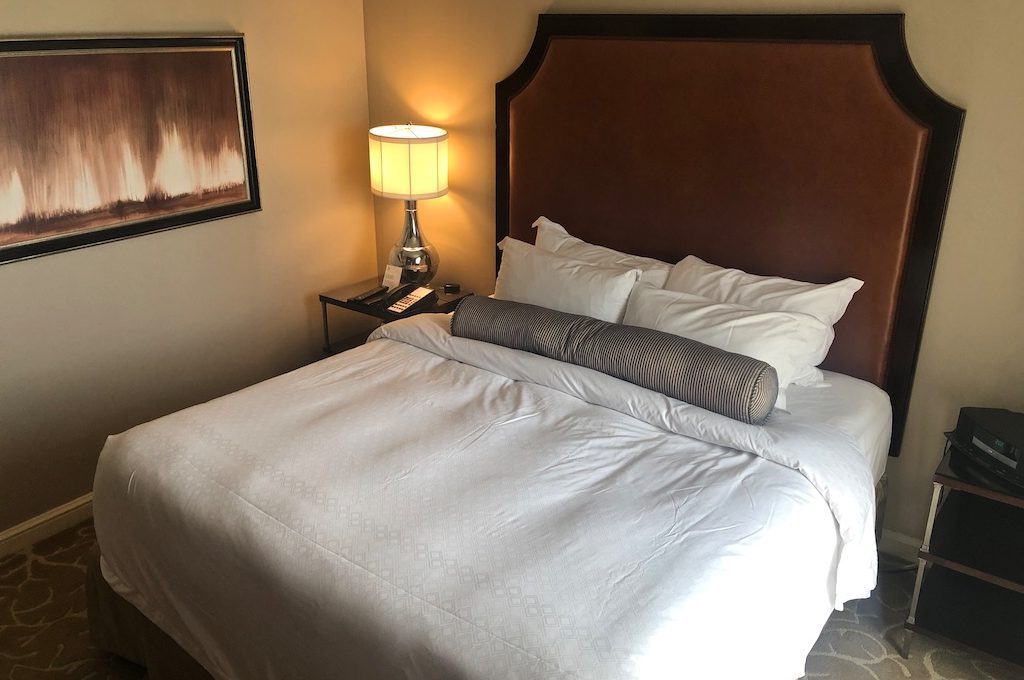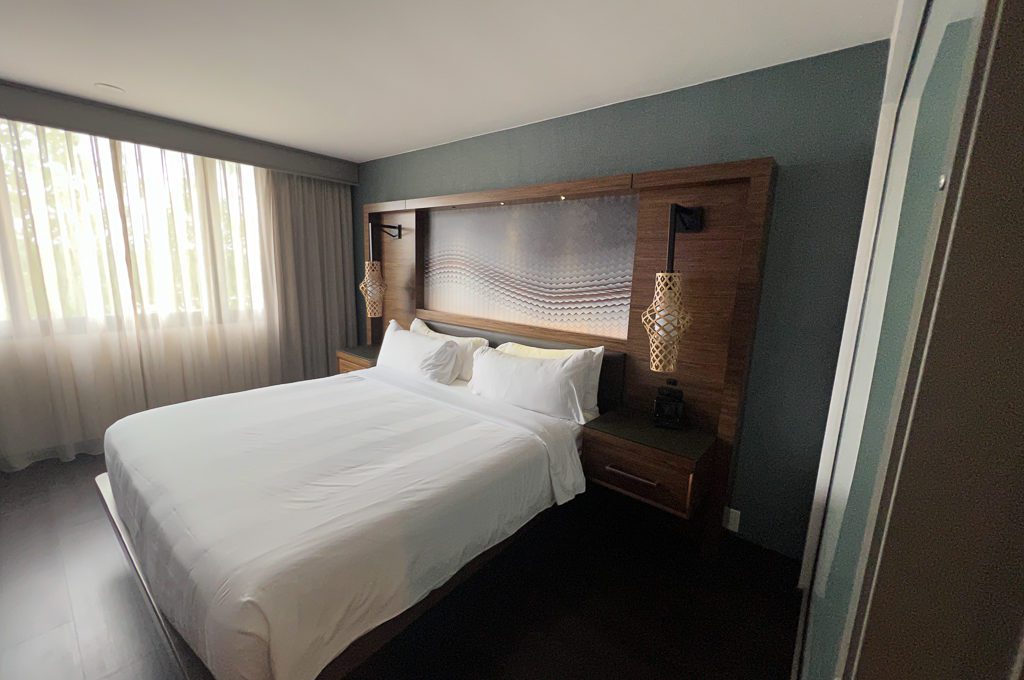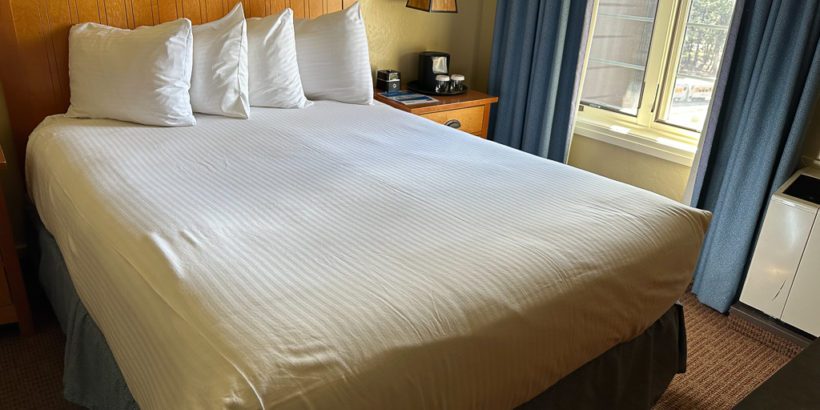Hotels are famous for providing exquisitely clean and white sheets.
You’ve probably never seen cleaner white sheets than in a hotel room (or at least that’s how we hope your experience has been — there are definitely some less desirable experiences out there).
But at a quality property, hotel sheets are almost always clean, white, and soft — like they just came out of the packaging.
And there’s a good reason for that.
Hotels invest heavily in cleaning technology. They use the best soaps and the latest washing machines and employ the best cleaning practices.
They do this because clean white sheets give a luxurious feel and prove the room is clean. While you can’t do everything that hotels do, you can replicate hotels’ cleaning methods at home.
Table of Contents
How do hotels keep their sheets so white?
Walk into a hotel room, and you’ll be greeted with a pristine white hotel sheet. Not only will it not have any visible stains or creases, but it’ll also be soft to the touch. You might even think the sheet’s brand new just for you. It most likely isn’t.
Hotels do purchase new sheets when needed. But they don’t give every guest a new sheet. Instead, hotels keep their sheets white and clean by constantly cleaning them with some powerful tools.
They do this because large numbers of hotel guests will use and dirty up the sheets over time. And it’s more economical to clean existing sheets than to buy new ones for every guest. As for how they clean the sheets? Hint: They don’t use regular bleach and hot water.
Naturally, since hotels have to deal with a mountain of laundry every day, they can’t hand wash every sheet with a stain. Instead, hotels have a few unique cleaning methods:
- Stain removers and soaps
They use large quantities of stain removers and the latest soaps to wipe away stains.
- Batch cleaning
Hotels commonly place a large amount of laundry in a big “pot” containing a mixture of cold water, laundry detergent, and baking soda. They’ll boil the sheets in this for up to half an hour before wiring the laundry.
- Fabric softener and bleach
The final step involves using fabric softener and bleach to bring out the sheet’s white color. They’ll use cold water since hot water breaks down linen faster.
Getting those bed sheets clean and white is an expensive and time-consuming process. Hotels use a lot of water and energy. But they do it because it saves them from buying new sheets for every guest.
In fact, hotels invest heavily in the latest cleaning technology. For example, they’ll use cleaning solutions and tech that even breaks down microscopic dirt with modulated ultrasonic waves.
Related: Do Hotels Wash Bedding Between Stays?

Why do hotels use white sheets?
White sheets are expensive to maintain. They’re also notoriously easy to stain. So why use them? It’s because they’re luxurious. Also, since they’re easy to stain, an unstained white sheet proves the sheets are clean.
Imagine if hotels used darker-colored sheets. It’d be much harder to tell if they’re clean. In contrast, an unstained white sheet is an instant proof that it’s clean. So hotels use the fact that white sheets are easy to stain to their advantage.
An unstained white sheet just looks clean. It’s more likely to please guests, giving a hotel room a more luxurious feel. Even a dated room looks much better with clean white sheets, giving it a fresh and clean appearance.
Hotels know this, and they want to give you a good impression. They know giving you cleaner and nicer-looking rooms means you’re more likely to stay again. So it’s worth it for them to invest in cleaning white sheets if it means more people stay.
The final reason why hotels use white sheets is that they’re easier to clean. If all your sheets are white, you can wash them all together instead of sorting them separately.

5 rules for keeping hotel sheets white
Hotels use these five rules to keep their sheets clean and white.
1. Spot cleaning prevents permanent staining.
Spot cleaning is the best way to remove permanent stains, especially on white sheets. Spot cleaning will always be more effective than dumping large amounts of detergent in the laundry.
So hotel personnel are required to separate deep stained sheets for cleaning. The deep stained sheets are then brought to a separate laundry area. The deep stained sheets are treated separately.
Hotels use Heavy Duty Detergent (HTD) to spot clean deep stains. HTD contains phosphates that remove even the worst stains–far more effectively than indiscriminate cleaning.
In fact, spot cleaning is the only effective way for anyone to remove deep stains–hotel or not. You just can’t remove deep stains by repeated cleaning. In fact, doing so will likely just damage the rest of the sheet.
Related: Should You Tip Hotel Housekeeping?
2. Use of different washing techniques
Hotel sheets receive different types of stains, i.e., juice stains, tomato stains from makeup and greasy food, etc. Different stains have to be treated differently. Else, they won’t get washed properly.
So hotels have different stains identified and treated accordingly.
- Sheets with makeup stains are soaked in chlorine bleach, water, and detergent before being rinsed.
- Tomato stains are pre-treated, then bleached.
- Greasy food stains are broken down with sweeteners to break down the oil and baking powder before being washed.
Hotels usually clean stained sheets first because it’s generally better to clean a stain as early as possible. Their laundry departments are trained to identify and treat the different stains appropriately.
3. Use of peroxide detergent
Most people assume the only way to clean a white sheet is with bleach. In reality, while bleach is a good cleaning agent, it’s not always ideal. Bleach is caustic, meaning it can burn and corrode the sheet’s fibers. So hotels don’t use it all the time.
Instead, they use peroxide-based laundry detergents for most of their cleaning. These types of detergents are highly effective but less caustic than bleach. Peroxide-based detergents even help prevent white sheets from graying or yellowing.
So hotels use peroxide detergent regularly to clean their sheets. It’s an effective agent for removing most stains.
4. Use of Cold Water & Drying
Contrary to popular opinion, hot water isn’t the best for cleaning sheets. That’s because hot water breaks the linen fibers more easily than cold water. For that reason, hotels use cold water.
They can’t afford white sheets regularly breaking down after cleaning. They’ll only use hot water for deep stains. All other sheets are regularly cleaned with cold water.
Hotels are also careful about laundry soap use. They calculate the amount needed to distribute evenly in a laundry pile. Using too little or too much won’t properly clean the sheets.
After cleaning, they reduce dry time by using a lower setting since drying quickly wears fibers faster.
5. Using a Professional linen service provider
Smaller hotels can’t afford a professional in-house laundry facility. Those are expensive. Luckily for them, they can outsource their laundry needs to hotel linen service providers.
Professional linen service providers are already experts in how to make linen. So they’re the best choice to outsource linen cleaning needs. They generally use the same equipment as the setup described above.
The advantage of outsourcing to a professional linen service provider is that it saves the hotel from investing in operating an in-house laundry facility.
The hotels will transport their laundry to the service providers, who will have their own professional laundry facilities. The service providers will clean the sheets for the hotel and send them back.
Most small hotels outsource to professional linen service providers since they can’t afford an in-house alternative. But most larger hotels prefer to clean their own laundry if they can afford it.
How do I make my sheets white like the hotels?
You might not be able to build your own in-house laundry facility. But here are a few steps you can follow to get crisp white linen sheets at home:
- Purchase high-quality white sheets. This can be a bit of an investment, but it’s worth it. High-quality sheets last longer.
- Use a good quality laundry detergent and either vinegar or baking soda with a 1:1 ratio. Vinegar and baking soda are both excellent cleaning agents readily available in most homes.
Ensure you don’t overuse either of the two. That could damage the sheets. Measure the amount of detergent, baking soda, and vinegar you use to prevent excess use. - Use a good quality fabric softener to make your sheets soft and smell good. This step is optional, but it’s great for replicating the feel of hotel sheets.
Use moderately hot water and bleach to clean out stains. Emphasis on moderate usage. Remember that too much hot water and bleach could damage the linen fibers.
- Ring out excess water and laundry soap. Doing so keeps the sheets soft. Too much detergent and soap suds make sheets become tougher. Keeping them soft lets them last longer.
Use a dryer sheet to wash your sheets for 50 minutes. Dryer sheets also help keep sheets fresh and soft.
- Also, dry your sheets carefully. The threads are more likely to come off looser after being cleaned.
- While washing, ensure that you spot clean deep stained sheets, especially if you have a smaller washing machine. Spot cleaning is the only way to effectively remove deep stains.
- It may also take you a few tries before your own sheets compare to hotel ones. But as long as you wash carefully with the right agents, you’ll have clean white sheets just like those in a hotel!
Final word
In conclusion, hotel sheets are so white and clean because hotels invest in effective cleaning methods.
Hotels have professional laundry facilities with the latest cleaning tech and methods, ranging from heavy-duty detergents for deep stains to modulated ultrasonic waves for microscopic dirt. Hotels invest this much in cleaning their white sheets to give a good impression and avoid constantly buying new sheets.
You can even replicate how hotels clean their sheets at home by buying high-quality sheets and cleaning them with good-quality laundry detergent.
Daniel Gillaspia is the Founder of UponArriving.com and the credit card app, WalletFlo. He is a former attorney turned travel expert covering destinations along with TSA, airline, and hotel policies. Since 2014, his content has been featured in publications such as National Geographic, Smithsonian Magazine, and CNBC. Read my bio.

